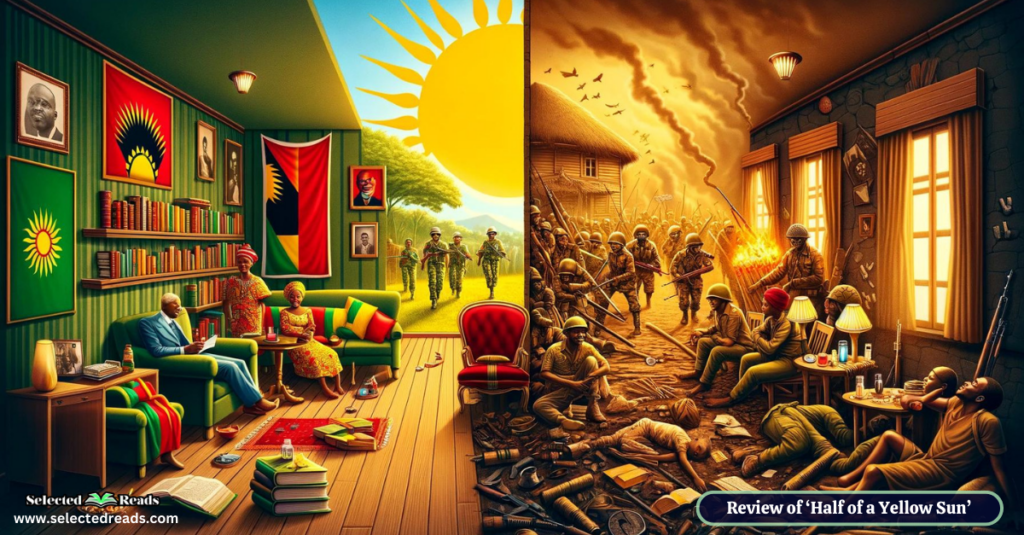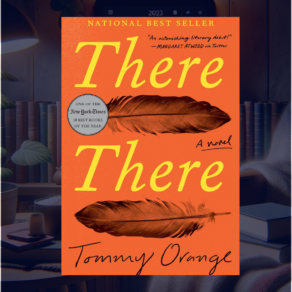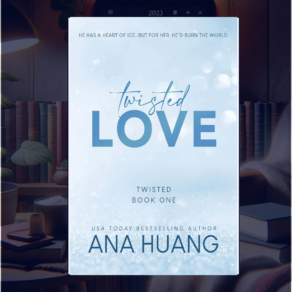“Half of a Yellow Sun” by Chimamanda Ngozi Adichie is the focus of our post today. This novel, a poignant work of historical fiction, plunges us into the heart of Nigeria’s Biafran War, recounting a complex tale of love, betrayal, and the struggle for independence. The purpose of this post is to familiarize you with the intricacies of Adichie’s narrative and the vibrant tapestry of characters she creates, all without spoiling the profound emotional and historical journey that awaits you.
My discussion will proceed as follows: First, I’ll provide a summary of the novel, setting the stage for our exploration of its themes and historical backdrop. Next, I discuss the richly drawn characters whose lives provide the lens through which we experience the turmoil and transformations of the era. To wrap up, I’ll offer some thought-provoking book club questions designed to spark deep discussions and further reflection on this unforgettable story.
Half of A Yellow Sun Summary
“Half of a Yellow Sun” by Chimamanda Ngozi Adichie intricately weaves a tapestry of lives caught in the midst of the Nigerian Civil War, also known as the Biafran War, which took place between 1967 and 1970. The novel is within the context of Nigeria’s struggle to establish an independent republic in southeastern Nigeria, named Biafra. Through the intertwined stories of its characters, Adichie offers a profound exploration of love, loyalty, and the ravages of war.
The narrative is structured around three central characters whose lives become interlocked by the war and its consequences. Ugwu, a thirteen-year-old boy from a rural village, is employed as a houseboy for Odenigbo, a charismatic and idealistic university professor in the city of Nsukka.
Photo: Amazon
Odenigbo is deeply involved in the political tumult of the times, hosting intellectual gatherings and passionately advocating for a free Biafra. Living with Odenigbo is Olanna, the sophisticated and beautiful daughter of a wealthy Nigerian businessman. Olanna has left her privileged life in Lagos, and her twin sister Kainene, to be with Odenigbo, embracing both the simplicity and complexities of her new life in Nsukka.
Kainene, Olanna’s twin, is a sharp contrast to her sister; practical, business-minded, and seemingly detached. She becomes involved with Richard Churchill, an English writer and expatriate, who is drawn to Nigeria by his fascination with the country and its history, and eventually, by his love for Kainene. Richard’s perspective provides an external viewpoint on the events unfolding in Nigeria, offering insights into the cultural and political chasm between the British and the Nigerians during this period.
As the war escalates, the lives of these characters are thrown into chaos. The conflict forces them to confront the worst of humanity—violence, betrayal, and the desperation of survival. Ugwu’s journey from a naive village boy to a soldier in the Biafran army encapsulates the tragic loss of innocence and the brutal realities of war. Olanna and Odenigbo’s relationship is tested by the strains of war, including personal betrayals and the relentless pressure of survival in a war-torn country. Kainene and Richard’s relationship, meanwhile, navigates the complexities of cross-cultural understanding and the uncertainties of a future in a divided nation.
Throughout the novel, Adichie uses the symbol of the half of a yellow sun—representing the Biafran flag—as a beacon of hope, unity, and national identity for the Biafran people. It signifies the aspirations for independence and the promise of a brighter future, which ultimately contrasts with the disillusionment and grief caused by the war.
The novel closes without a tidy resolution, reflecting the complex and ongoing impacts of the conflict on its characters and the nation. The fate of some characters remains uncertain, mirroring the unresolved nature of the war’s legacy in Nigeria. Besides recounting the historical events of the Biafran War, “Half of a Yellow Sun” also delves deep into the emotional and psychological landscapes of its characters, presenting a vivid and enduring picture of the human condition in times of conflict.
Related: The Book Thief Summary
Half of A Yellow Sun Characters
“Half of a Yellow Sun” by Chimamanda Ngozi Adichie presents a rich cast of characters, each offering a unique perspective on the events of the Nigerian Civil War and the broader themes of love, identity, and the struggle for independence. Below is an overview of the primary characters in the novel:
- Ugwu: A young boy from a village who becomes a houseboy for a university professor, Odenigbo. Ugwu’s journey is one of significant transformation—from an innocent, rural boy to a participant in the war, witnessing and enduring the horrors of conflict. His perspective provides a poignant look at the loss of innocence and the impacts of war on the individual.
- Odenigbo: A charismatic and intellectual professor at the University of Nigeria, Nsukka. He is deeply political, a fervent supporter of Biafra, and hosts intellectual gatherings at his home. His character is a blend of passion and idealism, often contrasting with the harsh realities of the war and its effect on his personal life, especially his relationship with Olanna.
- Olanna: Odenigbo’s partner, who comes from a privileged family in Lagos. She abandons her comfortable life to be with Odenigbo in Nsukka, facing the challenges of their relationship and the war. Olanna is a figure of beauty, strength, and resilience, dealing with personal betrayal and the atrocities of war while striving to maintain her sense of self and compassion.
- Kainene: Olanna’s twin sister, markedly different in temperament—pragmatic, business-minded, and seemingly more detached. Her relationship with Richard Churchill, a British writer, offers insights into the complexities of love across cultural divides during tumultuous times. Kainene’s storyline explores themes of identity, loyalty, and the search for purpose amidst chaos.
- Richard Churchill: A shy and introverted British writer fascinated by Nigeria, who becomes romantically involved with Kainene. Richard’s perspective as an outsider provides a nuanced view of the cultural and political tensions in Nigeria, the conflict in Biafra, and his own search for belonging and identity. His character also reflects on the role and limitations of Western involvement and understanding of African struggles.
- Mama: Odenigbo’s mother, who disapproves of his relationship with Olanna, particularly due to ethnic prejudices. Her character highlights the internal divisions within Nigeria and the impact of these divisions on personal relationships.
- Miss Adebayo: A colleague of Odenigbo’s who frequents his dinner parties. She represents the educated Nigerian elite who are politically and socially active in the discourse surrounding independence and the civil war.
- Okeoma: A poet and friend of Odenigbo, involved in the Biafran cause. His character adds a layer of cultural and intellectual response to the political upheaval and serves as a voice for the emotional and psychological toll of the conflict.
Half of A Yellow Sun Book Club Questions
Creating book club questions for “Half of a Yellow Sun” by Chimamanda Ngozi Adichie offers an excellent opportunity to explore the novel’s rich themes, complex characters, and historical backdrop. Here are some thought-provoking questions to stimulate discussion in your book club:
- Character Dynamics: How do the relationships between the main characters (Ugwu, Odenigbo, Olanna, Kainene, and Richard) evolve throughout the novel? Discuss how the war impacts these relationships and what it reveals about each character.
- Themes of War and Peace: How does Adichie portray the effects of war on individuals and communities in the novel? Consider the psychological, emotional, and physical impacts depicted in the story.
- Representation of History: “Half of a Yellow Sun” is set against the backdrop of the Nigerian Civil War. How does the novel contribute to your understanding of this historical event? Do you think fiction is an effective way to explore and represent history?
- Symbols and Motifs: Discuss the significance of the novel’s title and its symbol, the half of a yellow sun. What does it represent for the characters and for Biafra? How do other symbols or motifs in the book enhance its themes?
- Perspectives on Identity: How do the characters’ identities (national, ethnic, personal) affect their actions and experiences? In what ways does the novel address the construction of identity in the face of conflict?
- Colonialism and Its Aftermath: Explore the novel’s exploration of colonial legacies and neo-colonialism. How do these historical contexts shape the events of the Biafran War and the characters’ lives?
- Female Characters and Gender Roles: How are women portrayed in the novel? Discuss the roles of Olanna, Kainene, and other female characters in the context of 1960s Nigeria and the war. How do they navigate societal expectations and their own aspirations?
- Moral Ambiguity and Survival: The characters in the novel often face morally complex decisions, particularly in the context of war. Discuss instances of moral ambiguity and the choices characters make to survive. Are these choices justified?
- The Role of Art and Literature: Richard is a writer, and the novel includes discussions about the importance of art and literature. What role do art and literature play in the novel, both as themes and in the lives of the characters?
- Impact and Legacy of War: By the end of the novel, what do you think Adichie is saying about the long-term effects of war on individuals and nations? How does the novel’s ending reflect on the possibility of recovery and reconciliation?
- Comparative Analysis: If you have read other works by Chimamanda Ngozi Adichie or other novels set during the same period, how does “Half of a Yellow Sun” compare in its treatment of themes like war, love, and identity?
Related: Beloved Toni Morrison Summary
Final thoughts
To conclude, I hope that you have found this short review of “Half of a Yellow Sun” interesting and enlightening. Chimamanda Ngozi Adichie’s novel is a compelling exploration of love, war, and identity set against the backdrop of one of the most turbulent periods in Nigerian history. If you have not already immersed yourself in its pages, I highly recommend that you do.









